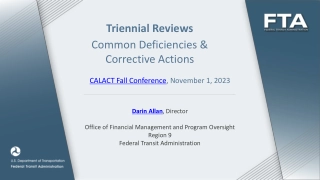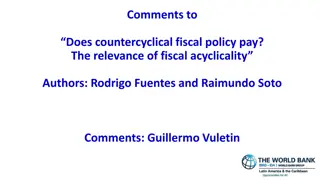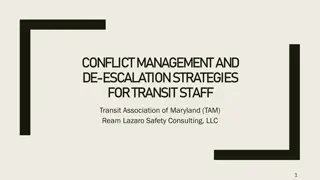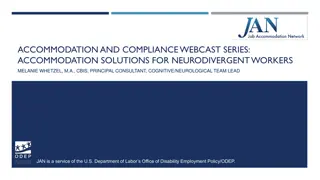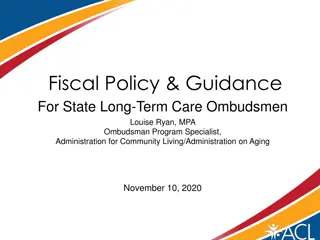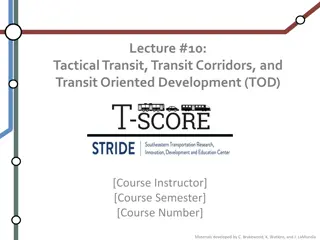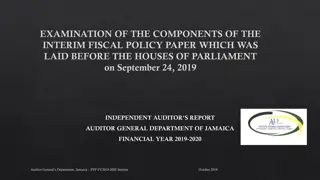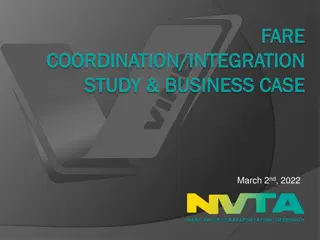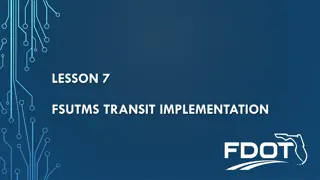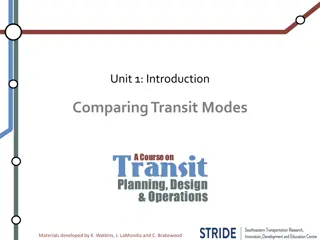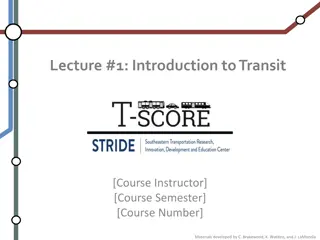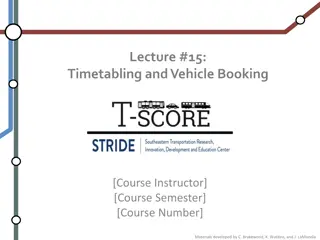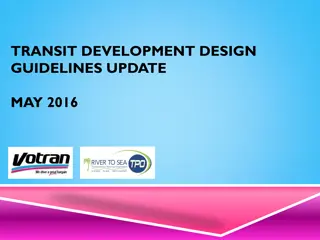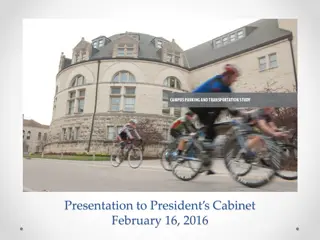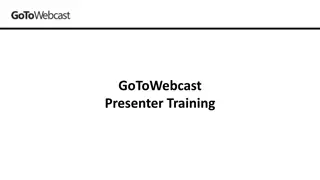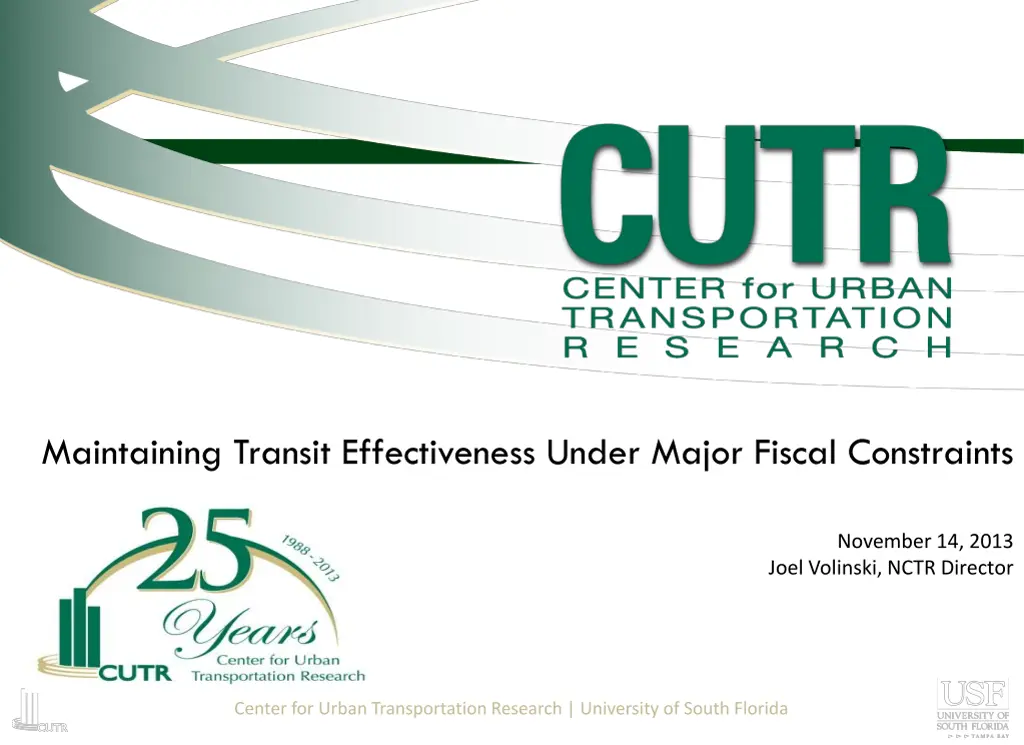
Strategies for Maintaining Transit Effectiveness Amid Fiscal Constraints
Explore how transit agencies tackled challenges during the Great Recession by identifying cost-saving and revenue-generating techniques. Discover the impacts on customers and the choices made to sustain transit services under major financial limitations.
Download Presentation

Please find below an Image/Link to download the presentation.
The content on the website is provided AS IS for your information and personal use only. It may not be sold, licensed, or shared on other websites without obtaining consent from the author. If you encounter any issues during the download, it is possible that the publisher has removed the file from their server.
You are allowed to download the files provided on this website for personal or commercial use, subject to the condition that they are used lawfully. All files are the property of their respective owners.
The content on the website is provided AS IS for your information and personal use only. It may not be sold, licensed, or shared on other websites without obtaining consent from the author.
E N D
Presentation Transcript
Maintaining Transit Effectiveness Under Major Fiscal Constraints November 14, 2013 Joel Volinski, NCTR Director Center for Urban Transportation Research | University of South Florida
Study Sponsor and Objective Funded through TCRP Synthesis Program (SA-30) Due to be published by Spring of 2014 Identify actions transit agencies have taken to maintain effectiveness during the Great Recession Effectiveness means providing as much quality service as possible in keeping with community values while normal sources of revenues were reduced Identify cost savings and revenue generation techniques and processes to work with employees and the public during difficult times
Methodology Survey sent to 46 transit agencies of all sizes throughout the country Extensive literature search including recent articles in newspapers and industry magazines Considerable information collected from personal emails with transit managers
Results of Surveys/Literature Search Survey responses received from 40 agencies (87% response rate) Emails from over 40 other transit managers Dozens of newspaper and magazine articles Over 200 techniques were reported from 100 different agencies
Painful Recession-Driven Choices Layoffs Hiring Freezes Wage Freezes Furloughs Elimination of Vacancies Reduced training and professional development Deferred Maintenance/Reduced Capital
Impacts on Customers 84% of agencies reported they considered raising fares or cutting service 59% already had done so by April 2010 MARTA to slash a quarter of service MTA to eliminate 1,000 positions Riders to feel steep CTA cuts Monday End of the line for PDRTA? Community Transit cut service 29%
Responding agencies service reductions by type between 2008 and 2012
Impact on Employees Agencies reported eliminating up to 30% of administrative positions, consolidating functions, restructuring, broadening jobs A deep sense of grieving during the layoff period and thereafter, increased levels of stress, lowered morale, risk avoidance, and withdrawal. There is a limit to how much smarter you can work Outsourcing administrative work comes with reduced quality of service We had to give managers permission to do less Open communication on changes is the best approach Survivor s guilt
Consequences of Fiscal Constraints In spite of a majority (59 percent) of responding transit agencies providing fewer total service hours in FY 2012 than in FY 2008, the majority of agencies (62 percent and 60 percent) carried more passengers per hour and more total passengers in FY 2012 than in FY 2008. Transit agencies are becoming more efficient, partially due to necessity, but also due to better management
Managing Resources is Critical Creativity/desperation is still alive and well. The structural problem was/is huge, and these techniques might not bridge all budget gaps, but agencies can still help themselves. Some actions were significant and others minor, but all are evidence of systems that are doing everything possible to avoid cutting service or asking for more tax support
How agencies felt they were doing comparing 2012 to 2008
More Data-Driven Management GCRTA s TransitStat program, CTA s Performance Measurement Program, UTA s ISO 14001 process, SCRTA s Key Performance Indicators, Nashville MTA s Results Matters program, San Joaquin s TransTrack, MDT s Six Sigma process All provide business intelligence solutions that transforms volumes of data into meaningful information for managers to use in developing immediate actions, strategies, and plans to ensure optimal operations and performance American Bus Benchmarking Group
Savings in Paratransit In-house assessment allow accurate determination of passengers capabilities to use fixed route service Passengers are either going to be eligible for paratransit services, get a half-price fare card, or participate in travel training and become fixed-route users http://www.metro-magazine.com/images/blogs/M-KemptonBlogACCESStransitcenter.jpg
Savings in Paratransit Switching from Cutaways to Minivans or hybrid vehicles (or propane vehicles) to save substantially on fuel Using taxis for short trips, hard-to-route trips, or for unusually high peak demand Using 15-minute video to show at assisted living centers to educate passengers to fixed route alternatives Partnering with local non-profit agencies to provide trips Scheduling software and mobile data terminals increase productivity IVR reduces no-shows and dwell time
Maintenance efficiencies Electrification of bus components such as air conditioning, engine cooling, power steering to reduce parasitic load and save as much as 15% on fuel Conversion of fleets to CNG Bringing light rail maintenance in house saved $1.6 M Contracting out bus maintenance saved $250,000 at NCTD Using 3rdparty vendors to handle inventory Use of software to monitor preventive maintenance and fluid consumption Using developmentally disabled to clean buses
Savings from Greener Facilities SEPTA saved $100,000 (12%) a year in utility costs at headquarters by: Cleaning offices during the day Installing motion detection light switches Installing more energy efficient AC and boilers Less energy-hoggish elevators and escalators Installing LED lighting wherever possible Installing film on south-facing windows Considering wind power capture on roof of headquarters Installing a wayside energy storage device at substations along rail tracks that will Save $190,000 a year and allow them to sell excess energy
Efficiencies in utilities Base Interruptible Programs are used at Connecticut Transit and Long Beach Transit to reduce electricity rates Solar trash compactors are used at PSTA with sensors that communicate when trash needs to be removed VTA installed solar panel canopy systems to park buses under for shade, savings on future energy costs, and reduced footprint
Controlling Health Care Costs and Workers Compensation HART decided to self-insure and pay for claims less than $100,000 after paying $5.4 million more in premiums than the claims totaled over 5 years Higher co-pays, but premium differential is offered based on participation in wellness programs Contract for Third Party Administrators to handle Workers Comp claims and FLMA Alternative work assignments (Light duty) reduced time away from work from 91 to 47 days at WMATA
Efficiencies through Technology AVL and signal priority have improved scheduling and on-time performance and customer satisfaction and reduced need for street supervision APCs have allowed reductions in hours, identified bus stops for elimination, and reduced required surveying Audible pedestrian warning system has reduced claims Scheduling software for paratransit and fixed route Enterprise Resource Planning platforms enable efficiencies in HR, Finance, Accounting Security cameras have led to many arrests and lower claims
Efficiencies through Technology Multimodal trip planners and Interactive Voice Response systems have allowed reductions in customer service staff SJRTD developed Text Bus to provide real time information on demand for each bus stop Virtualization technology reduces number of needed servers and reduce power consumption and AC Installation of Wi-Fi on express buses increased ridership by 8% in San Jose Social media improves customer information, reduces cost of printed materials, and permits 2-way communications
Marketing and Advertising Digital advertising is now on buses, at kiosks, stations, and billboards on transit properties (will bring CTA $3.3 million a year) Ads are also on farecards, system maps, websites, bus floors, etc. http://i.bnet.com/blogs/nycsubwaytouchscreen1.jpg
Marketing and Advertising Denver now wraps light rail trains and is scheduled to receive over $1.6 million annually Audio advertising is now in place in over a dozen small and mid-size transit agencies Ads for alcohol are now more common in major cities ($1.2 million for CTA)
Partnering in Marketing CTA has partnered with Groupon to sell three-day passes to visitors from around the world Online grocery store Peapod.com provides virtual grocery aisles at train stations and delivers selected products to passengers homes
Partnering in Marketing Redbox video kiosks are in place at CTA stations for ease of acquiring low cost video rentals Financial institutions are paying over $1 million per year for ATMs at transit stations in Chicago
Sale of Naming Rights Barclays has paid $4 million to name a new train station in Brooklyn, SEPTA realized $3 million from AT&T, and Chicago received $3.9 million from Apple TriMet sells naming rights to streetcar stops for $500 a month and the streetcars themselves for $25,000 a year
Revenues from Facilities SEPTA leased empty office space to earn over $7 million MBTA securitized parking facilities (50,000 spaces) by selling bonds secured by future parking revenues to receive a lump sum payment and pay off long term debt MDT leases property under its elevated heavy rail system to adjacent property owners for additional parking
Greater Use of Public Partners Military bases Universities Public schools Transportation Management Associations Downtown Development Authorities Convention centers Social service agencies Municipalities
Greater Use of Private Partners Shopping malls Business parks Museums Hotels Major employers and business associations Hospitals Casinos
New Sources of Operating Revenue Marin County passed a $10 increase in vehicle registration fees generating $2 M for transportation: transit gets 35% Corvallis passed a Transportation Utility Fee to replace ad valorem tax and remove transit from general fund Rhode Island passed a two-cent gas tax with all proceeds ($9M) going to transit (RIPTA) Sales taxes on internet purchases passed by Virginia and Maryland to enhance and/or replace gas taxes Surcharges on tickets to major events
Joel Volinski, Director National Center for Transit Research University of South Florida volinski@cutr.usf.edu 813.974.9847 CONTACT

